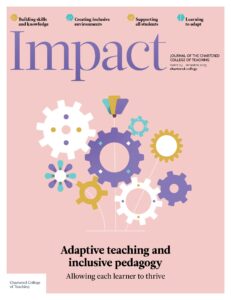Beyond age labels: Creating systematic approaches to resource assessment in inclusive education

SARA MURŠIĆ, FOUNDER, TOYSCOPE, UK
Educational resources offer rich opportunities for learning and complement teaching at all levels of education, yet selecting and assessing these materials for an increasingly diverse population of students remains a complex challenge. With more than 1.6 million pupils in England identified as having special educational needs and disabilities (SEND) (DfEDepartment for Education - a ministerial department responsible for children’s services and education in England, 2024), the guidance for selecting developmentally appropriate and safe resources for this population remains surprisingly limited. This article examines the current guidance gap in resource assessment and proposes practical approaches for developing more systematic frameworks, aiming to empower practitioners and leaders to make informed decisions that balance resource implementation opportunities with appropriate safety considerations. Building on initial work from the ToyScope project, which has developed resources for families navigating toy safety concerns, this article explores how similar approaches might be adapted for educational settings.
Navigating unclear waters between policy and practice
The statutory framework governing resource provision in education settings reveals significant gaps in specific guidance for inclusive practice. While the SEND code of practice (DfE, 2015) emphasises ‘reasonable adjustments’ and ‘appropriate resources’, it provides minimal practical direction for ensuring that resources are indeed adapted, appropriate and safe. The Royal Society for the Prevention of Accidents (RoSPA, 2023) provides comprehensive guidance for managing safety in schools, but primarily addresses general and mainstream settings, leaving practitioners in inclusive or specialist provisions to make professional judgments based on students’ education, health and care plans (EHCPs) or multidisciplinary team reports.
The National Autistic Society (2024) is one of the organisations working on addressing challenges in managing safety for pupils with additional needs, emphasising the importance of careful resource assessment and monitoring. As an example, its guidance on supporting students with pica (mouthing, chewing and ingesting inedible items) demonstrates how standard safety approaches may need significant adaptation for some learners, requiring constant vigilance and systematic assessment of all accessible materials.
Ofsted’s education inspection framework (2023) evaluates how well resources support learning and development, but offers no specific framework for documenting resource assessment decisions for pupils with SEND. This opportunity for professional interpretation invites educators to develop student-centred inclusive approaches, through a careful balance of appropriate safety measures and rich learning challenges. For school leaders preparing for inspections, clear documentation of resource assessment decisions becomes crucial. A systematic approach to recording adaptations and safety considerations not only supports daily practice but also provides evidence of ‘reasonable adjustments’ and demonstrates a robust risk-assessment process. This documentation can effectively showcase how resource choices actively support progress towards EHCP outcomes and curriculum access.
Similarly, the Teachers’ Standards (DfE, 2021) require practitioners to ‘adapt teaching to respond to the strengths and needs of all pupils’ (p. 11) and to have ‘regard for the need to safeguard pupils’ wellbeing’ (p. 14). This creates an additional imperative for careful resource assessment, as teachers must balance educational value with safety considerations in every lesson.
Current guidance on age-appropriate resources primarily relies on typical developmental milestones. The Consumer Product Safety Commission’s age determination guidelines acknowledge that standard age labels might not be suitable for all children, particularly those with diverse developmental profiles (CPSC, 2022). This creates additional layers of risk assessment, not only for practitioners in direct work, but also for leaders and administrators who handle the sourcing and purchasing of materials, as well as cleaners and/or facility staff who move or manage materials across different spaces.
Beyond the fundamental issue of determining appropriateness and safety, significant funding constraints in UK schools create additional pressures. More than 1,000 schools across England are turning to crowdfunding websites and wish lists to raise money for resources (Adams, 2019), with many schools working with community donations of second-hand materials for teaching and play. The latest government data shows increasing numbers of schools falling into financial deficit (NEU, 2024), forcing difficult compromises in resource provision. Regardless of where the resources come from, clear protocols for regular safety and usage checks of new, donated or existing learning and play resources should be regular practice in all settings. Less is sometimes better, particularly if it translates into fewer accidents.
Proactive incident prevention requires systematic approaches rather than reactive responses. Settings that implement regular resource audits, clear communication protocols about safety concerns and systematic documentation of near-misses report fewer safety incidents and better resource management. This preventative approach not only protects pupils but also reduces staff anxiety about resource choices and helps to maintain appropriate risk-taking in learning activities.
| Through the practitioner’s lens
A Year 1 (five-year-old) student with autism and pica needs enriching resources that are appropriate for their age, interest and cognitive development. To meet these needs, staff should not only find materials that are stimulating, age-appropriate, educational and interesting for the student, but also ensure that no small parts are accessible, despite standard age labels approving toys with small parts for children over the age of three years. Additionally, all spaces where group activities, transitions or therapeutic work are carried out should be prepared and checked in advance, since other students or staff could accidently leave items of risk in those spaces. Current guidance recognises the exceptions to labelling and warns practitioners of the need for professional judgment, but offers limited support, training or guidance for such decision-making within a large, busy classroom, among many other students and individual needs. Note: This example comes from professional experience in UK schools and has been fully anonymised, with all identifying details removed to ensure confidentiality. |
Practical advice for resource selection and safety management
While implementing new systems initially requires time investment, clear protocols actually reduce the daily decision-making burden on staff. The structured approach suggested below aims to help to reduce the cognitive load of constant on-the-spot decisions about resource safety and suitability. Each element can be implemented incrementally, allowing settings to build their system at a pace that works for their context.
1. Understand the individuals and the group
Begin by collating the information that you have about students within each group, to make sure that each member of the team (including temporary or support staff) understands each student’s specific needs, sensory processing, preferences and behavioural responses (Fisher, 2016). This activity, usually carried out at the start of each academic year, demonstrates a child-centred approach and ensures that resources can be matched to support each learner’s development effectively. As an additional step, plan for materials that can be used in pairs or groups, while respecting each individual student’s sensory or other need. Remember that this understanding is not static. Children’s needs change, and unexpected situations arise daily in educational settings. Regular observation and responsive adaptation of resource remains essential, even with the most careful initial planning. This flexibility allows practitioners to respond confidently to each child’s changing needs and the unpredictable nature of classroom dynamics.
2. Collaborate with your team
Use any regular team meetings involving teachers, teaching assistants, SEND coordinators and therapists to share or jointly decide on some of the more complex resource choices. This collaborative effort uses diverse expertise and fosters consistency in practice across the setting (Siraj-Blatchford, 2009).
3. Create basic resource inventories
Develop simple resource inventories that note any safety considerations, adaptation possibilities and usage guidelines. This foundational step is quick to implement and can evolve into more sophisticated systems over time. For example, the ability to filter the list of resources to remove any items that produce loud noises can be useful when planning activities for sensory-sensitive students (Ashburner et al., 2008). A quick checklist helps to streamline the selection process and ensures that safety standards are met. Additionally, a clear inventory of resources can maximise their use across different groups and reduce the costs of ordering duplicate or similar items. This systematic approach is particularly valuable for settings that manage both purchased and donated resources, ensuring that all materials are used effectively.
4. Document successful adaptations
Log successful adaptations and share these with your team. Documenting what works for students builds a valuable knowledge base among staff and encourages a balanced approach to risk assessment, helping to avoid overprotective or dangerous activities (Little et al., 2012). This practice not only saves time in the long run, but also enhances resource effectiveness and safety.
Conclusion
As a growing number of students with SEND attend inclusive and mainstream education settings, and with increasing pressures on teaching and support staff, a more collaborative approach between schools, researchers and manufacturers is advocated. This could strategically improve the labelling of all play and learning resources to consider developmental domains beyond age recommendations – for example, via specific guidance for sensory needs, motor skills requirements and adaptation possibilities.
The path to better resource assessment systems does not need to add to workload. The ToyScope project has started to address these challenges by creating freely accessible video materials on toy safety for families. Building on this foundation, there is now an opportunity to develop similar resources that are specifically tailored for schools and early years settings. Educators who are interested in contributing their expertise to this collaborative effort can help to shape practical guidance that addresses the unique challenges of educational environments. By sharing successful practices and working together, we can create evidence-based frameworks that empower practitioners, enhance inclusive learning experiences and maintain appropriate safety standards for all learners.
- Adams R (2019) Cash-strapped English schools turning to online donations to close funding gap. Guardian, 9 April. Available at: www.theguardian.com/education/2019/apr/09/cash-strapped-english-schools-turn-to-online-donations-to-close-funding-gap (accessed 10 December 2024).
- Ashburner J, Rodger and Ziviani J (2008) Sensory processing and classroom emotional, behavioral, and educational outcomes in children with autism spectrum disorder. American Journal of Occupational Therapy 62(5): 564–573.
- Consumer Product Safety Commission (CPSC) (2022) Age determination guidelines: Relating consumer product characteristics to the skills, play behaviors, and interests of children. Available at: www.cpsc.gov/s3fs-public/pdfs/blk_media_adg.pdf (accessed 10 December 2024).
- Department for Education (DfE) (2015) SEND code of practice: 0 to 25 years. Available at: www.gov.uk/government/publications/send-code-of-practice-0-to-25 (accessed 10 December 2024).
- Department for Education (DfE) (2021) Teachers’ standards: Guidance for school leaders, school staff and governing bodies. Available at: www.gov.uk/government/publications/teachers-standards (accessed 10 December 2024).
- Department for Education (DfE) (2024) Special educational needs in England: January 2024. Available at: https://explore-education-statistics.service.gov.uk/find-statistics/special-educational-needs-in-england (accessed 10 December 2024).
- Fisher J (2016) Starting from the Child: Teaching and Learning from 3 to 8, 4th ed. London: McGraw-Hill Education.
- Little H, Sandseter EBH and Wyver S (2012) Early childhood teachers’ beliefs about risk in play. Early Years 32(2): 167–181.
- National Autistic Society (2024) Understanding and managing pica. Available at: www.autism.org.uk/advice-and-guidance/professional-practice/managing-pica (accessed 10 December 2024).
- National Education Union (NEU) (2024) School funding statistics. Available at: https://neu.org.uk/latest/press-releases/school-funding-statistics (accessed 10 December 2024).
- Ofsted (2023) Education inspection framework. Available at: www.gov.uk/government/publications/education-inspection-framework/education-inspection-framework-for-september-2023 (accessed 13 March 2025).
- Royal Society for the Prevention of Accidents (RoSPA) (2023) Managing safety in schools and colleges. Available at: www.rospa.com/rospaweb/docs/advice-services/school-college-safety/managing-safety-schools-colleges.pdf (accessed 10 December 2024).
- Siraj-Blatchford I (2009) Quality teaching in the early years. In: Anning A, Cullen J and Fleer M (eds) Early Childhood Education: Society and Culture, 2nd ed. London: SAGE, pp. 147–157.










